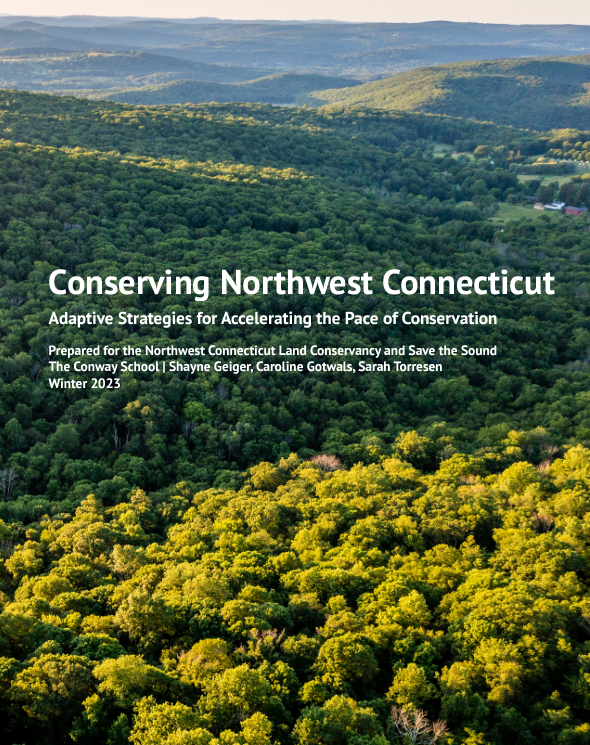
Kent, CT— Northwest Connecticut Land Conservancy (NCLC) and Save the Sound are pleased to announce the publication of Conserving Northwest Connecticut: Adaptive Strategies for Accelerating the Pace of Conservation. This innovative new publication documents the region’s conservation efforts and reveals strategies for accelerating the pace of conservation as part of the global initiative to conserve 30% of the Earth’s lands and waters by 2030, also known as 30×30.
The report was written in partnership with the Conway School of Landscape Design, with guidance from a core team of Connecticut land conservation groups including Connecticut Land Conservation Council, Follow the Forest (a program of the Litchfield Hills Greenprint Collaborative), Save the Sound, and The Nature Conservancy, with significant input from the region’s local land trusts and Councils of Government.
In 2021, NCLC evaluated Northwest Connecticut against a 30 x 30 goal and determined the current pace of conservation. Its analysis showed that the essential work of land conservation falls primarily on the region’s private, nonprofit land trusts. Collectively, these organizations protect 1,000 acres per year, on average. NCLC’s holistic evaluation of the conservation landscape encompassed a category identified as “quasi-protected” lands, which are lands held for conservation purposes but not permanently protected. These “quasi-protected” lands are primarily water company supply lands.
To meet the 30 x 30 goal in Northwest Connecticut, the new report found there can be no net loss of quasi-protected lands, and the land trust community must protect an additional 7,500 acres. Based on the report’s findings, creating the tactical roadmap for that increased land conservation will involve weighing three interconnected considerations—ecological, economic, and equitable.
“Accelerated land and water conservation are essential for protecting more than 300 rare and endangered species in Litchfield County, safeguarding against a changing climate, and ensuring equitable access to natural and working lands for the communities and people of our region. We are excited to work with individual landowners, communities, and the region’s land trusts to increase the pace of conservation,” said NCLC’s Executive Director, Catherine Rawson.
“Connecticut’s watershed lands are critical to the long-term health of Long Island Sound,” said Leah Lopez Schmalz, President of Save the Sound. “When conserved, they filter the water that feeds the Sound, and are essential in protecting the public’s drinking water. They also serve as critical resilience spaces that protect ecosystems and wildlife and provide access for everyone to restorative connections with the great outdoors. But with so many quasi-conserved spaces still vulnerable to potential development, we must remain vigilant and use every tool in our toolbox—legal, advocacy, restoration, science, outreach—to ensure we meet the land conservation goals that will sustain people and wildlife alike.”
The forests and uplands of Northwest Connecticut are part of a connected corridor of habitat called the Berkshire Wildlife Linkage that stretches from the Green Mountains of Vermont to the Hudson Highlands of New York and beyond. Its lands provide habitat for wide-ranging species, such as black bear, moose, and bobcat, and as much as 90% of the global breeding populations of dozens of migratory birds, including the Scarlet Tanager, Wood Thrush, and Black-throated Warbler. Northwest Connecticut’s land, 70% of which is forested, protects water quality in both the Housatonic and Connecticut Rivers, which flow into Long Island Sound. Its trees reduce the effects of severe heat and store carbon, mitigating greenhouse gas emissions. In addition, the recreational opportunities afforded by land preservation in Northwest Connecticut have a positive impact on human health as well as an economic benefit via tourism. The report found that all of these qualities make the area a natural leader in the movement toward greater land conservation and a potential example for other regions and states to follow.
Scientists predict that conserving the top-ranked 30% of land areas would conserve 62% of total carbon stocks, 68% of all fresh clean water, and improve the conservation status of 70% of at-risk species. “Conservation supports the health of our communities, economies, and ecosystems,” Rawson stated. “Our region’s lands and waters are vital for local food production, clean drinking water, a cooler climate, and outdoor experiences that are proven to positively impact human mental and physical health. With continued investment and partnership, we can achieve 30 x 30 in Northwest Connecticut for the benefit of people and wildlife now and in the future.”
Conserving Northwest Connecticut: Adaptive Strategies for Accelerating the Pace of Conservation is available for free here.
